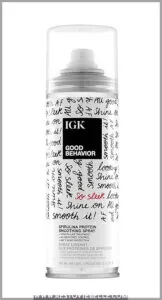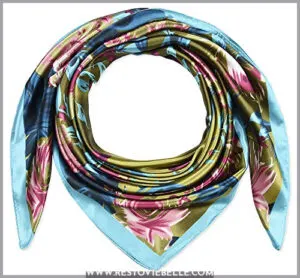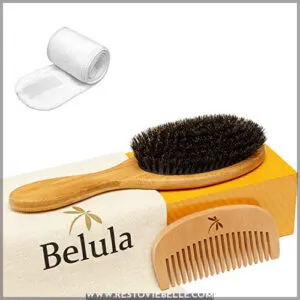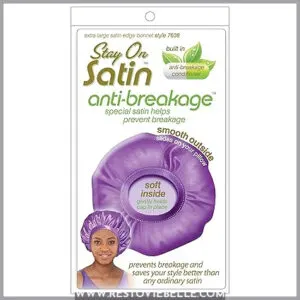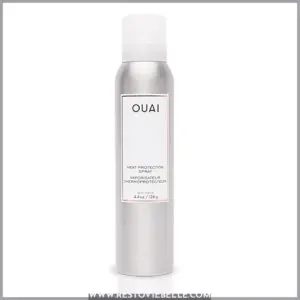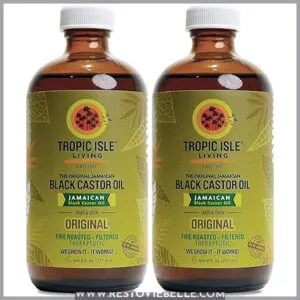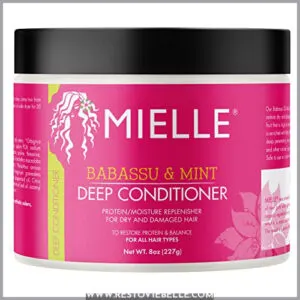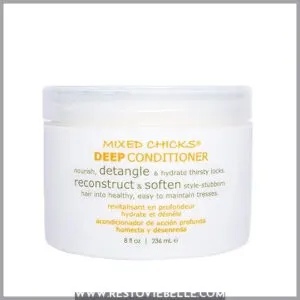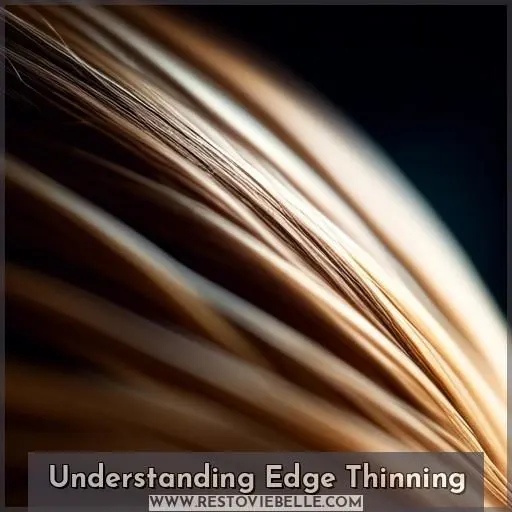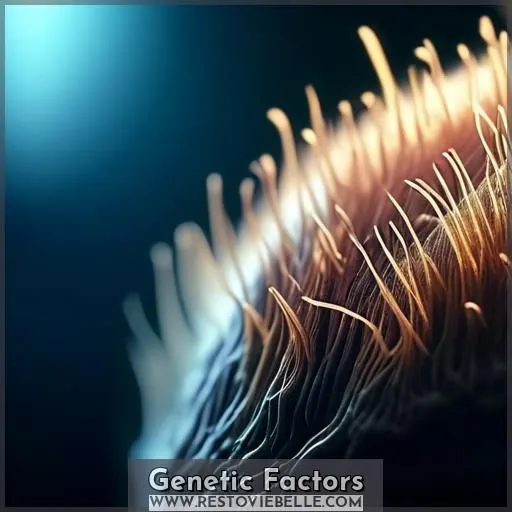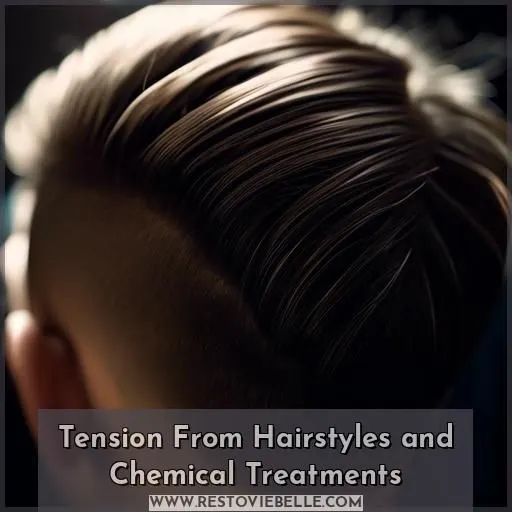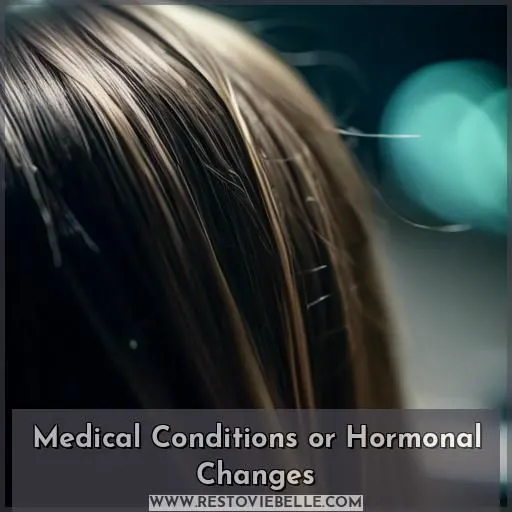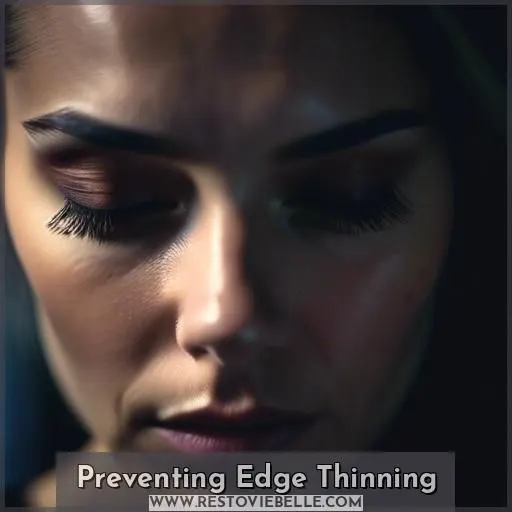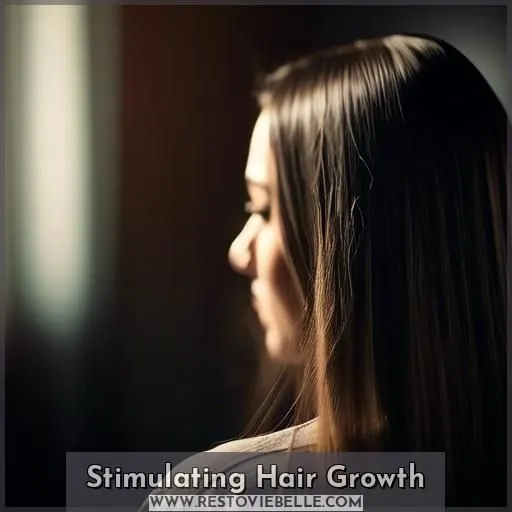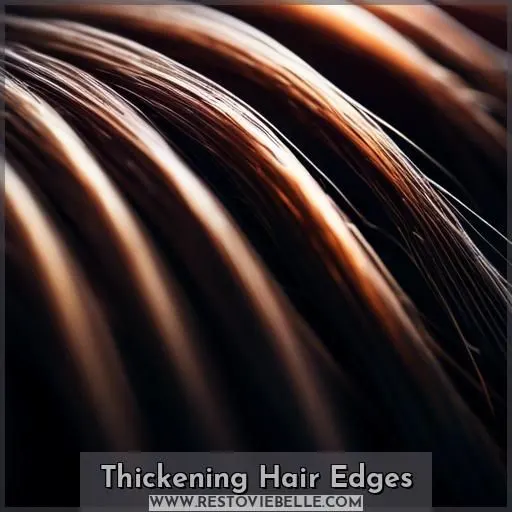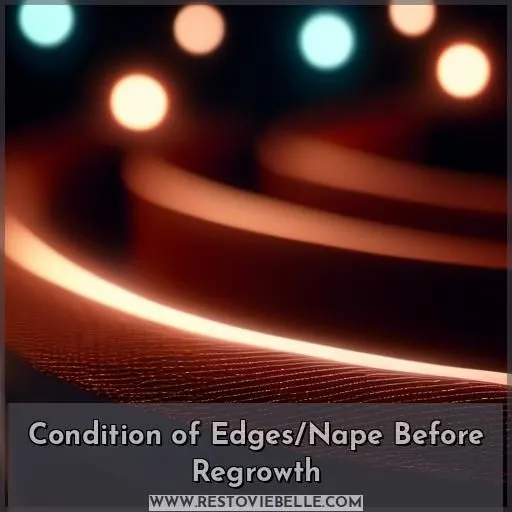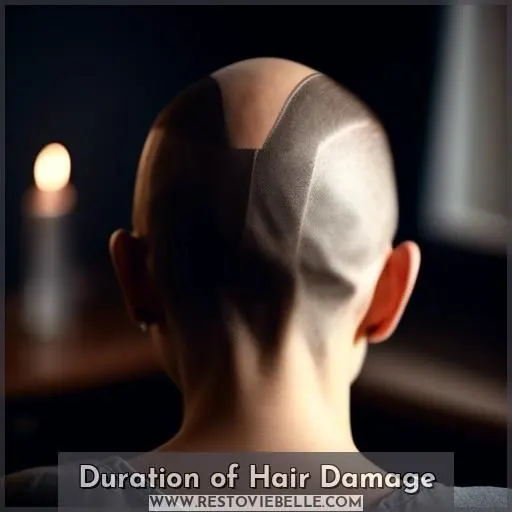This site is supported by our readers. We may earn a commission, at no cost to you, if you purchase through links.
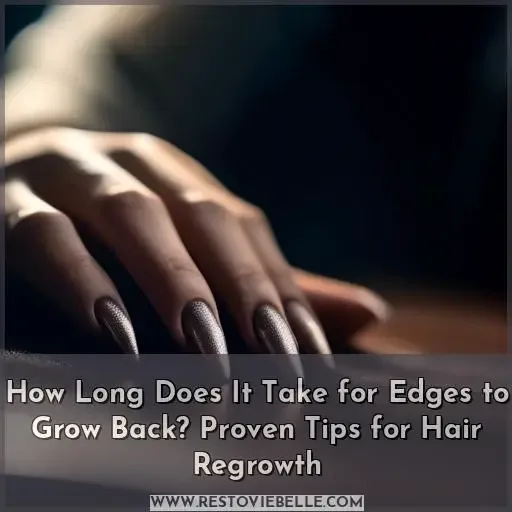 Your edges can regrow in as little as 4-6 weeks if you take consistent action to nourish your scalp and protect the fragile new growth.
Your edges can regrow in as little as 4-6 weeks if you take consistent action to nourish your scalp and protect the fragile new growth.
However, full restoration often requires 6-12 months of patient care.
You’ll need to identify and address the root cause, whether it’s traction alopecia from tight hairstyles, postpartum shedding, or product damage.
Stimulate hair growth through scalp massages, light therapy, and a protein-rich diet.
Avoid further breakage by limiting heat styling and using reparative treatments.
To thicken new edges, incorporate nourishing oils like Jamaican black castor oil or monoi oil.
With diligent effort, you can revitalize your hairline – but exploring relevant tips is key for best results.
Table Of Contents
- Key Takeaways
- How Long Does It Take for Edges to Grow Back?
- 10 Best Products for Edge Regrowth
- IGK Good Behavior Spirulina Protein Smoothing Spray
- Satin Silk Lightweight Hair Scarf
- Boar Bristle Hair Brush Set
- Stay on Satin Anti Breakage Bonnet Extra Large
- Ouai Multi-Purpose Priming Heat Protectant Spray
- Stay on Satin Edge Bonnet Hair Wrap
- Jamaican Black Castor Oil 8oz Pack of 2
- Mielle Organics Babassu Mint Deep Conditioner
- Mixed Chicks Detangling Deep Conditioner
- NatureLab Tokyo Perfect Clean Clarifying Scalp Scrub
- Understanding Edge Thinning
- Genetic Factors
- Tension From Hairstyles and Chemical Treatments
- Medical Conditions or Hormonal Changes
- Preventing Edge Thinning
- Stimulating Hair Growth
- Thickening Hair Edges
- Condition of Edges/Nape Before Regrowth
- Duration of Hair Damage
- Frequently Asked Questions (FAQs)
- Conclusion
Key Takeaways
- Edges can regrow in as little as 4-6 weeks with consistent nourishment and protection, but full restoration often requires 6-12 months of patient care.
- Identifying and addressing the root cause of edge thinning, such as traction alopecia, postpartum shedding, or product damage, is crucial for effective regrowth.
- Stimulating hair growth through scalp massages, light therapy, and a protein-rich diet, alongside using reparative treatments, can significantly aid in the regrowth process.
- Incorporating nourishing oils like Jamaican black castor oil or monoi oil into your hair care routine can help thicken new edges and revitalize the hairline.
How Long Does It Take for Edges to Grow Back?
It typically takes 6-8 weeks for hair to grow back after stopping stress and pressure on the area. The regrowth process can be influenced by factors such as consistency with treatment, eliminating causes of damage, maintaining high moisture levels, minimizing breakage, proper protective styling, and keeping ends clipped.
10 Best Products for Edge Regrowth
You can help promote edge regrowth by incorporating some proven products into your hair care routine. Some top options include:
Protein-rich formulas like the IGK Good Behavior Spirulina Protein Smoothing Spray.
Protective styles using the Satin Silk Lightweight Hair Scarf or Stay on Satin Anti Breakage Bonnet.
Stimulating scalp treatments such as Jamaican Black Castor Oil or the NatureLab Tokyo Perfect Clean Clarifying Scalp Scrub.
IGK Good Behavior Spirulina Protein Smoothing Spray
If you’re looking for a product to help your edges grow back, the IGK Good Behavior Spirulina Protein Smoothing Spray is a great choice. This plant-based protein spray is rich in amino acids, vitamins, minerals, and biotin, making it perfect for healing and nourishing your hair.
It also contains formaldehyde-free bonding polymers that help reduce blow-drying time and protect against humidity. Plus, it creates a frizz-free, high-shine finish, leaving your hair super soft and straight.
To use, simply spray it on after washing and before blow-drying. However, be aware that it has a strong smell, so use it in a well-ventilated area and spray lightly to avoid an overpowering scent.
Best For: Individuals seeking to heal and nourish their hair while achieving a frizz-free, high-shine finish.
- Plant-based protein rich in amino acids, vitamins, minerals, and biotin
- Formaldehyde-free bonding polymers reduce blow-drying time and protect against humidity
- Creates a frizz-free, high-shine finish
- Strong smell; use in a well-ventilated area
- May not be suitable for people who experience headaches easily
- Spray lightly to avoid overpowering scent
Satin Silk Lightweight Hair Scarf
When tucking in for the night, think of a satin silk lightweight hair scarf as your mane’s knight in shining armor. This 35 x 35-inch square of silky salvation wraps your edges in a gentle embrace, shielding them from the nightly friction that can lead to thinning.
It’s not just a pretty face; this scarf is a multitasker, doubling as a stylish accessory by day. So, bid adieu to breakage and say hello to hair that stays put, all while turning heads with its vibrant hues.
Best For: Fashion-forward women and girls seeking a stylish and protective hair accessory.
- Protects hair from breakage and thinning
- Can be used as a versatile accessory for various styles
- Lightweight and comfortable to wear
- Hand wash recommended
- May be too small for some hairstyles
- Not suitable for all hair types
Boar Bristle Hair Brush Set
You might be curious how a basic hairbrush can aid your hair regrowth journey. These brushes are crafted solely from 100% unadulterated boar bristles, which are delicate and gentle on your hair.
They aren’t intended for detangling or styling your hair, but they can facilitate the distribution of your hair’s inherent oils, fostering a vibrant shine. They’re most suitable for fine to medium hair textures, making them an excellent complement to your hair care regimen.
Well, let’s explore the realm of Boar Bristle Hair Brush Sets. If you seek a tool that can aid in restoring your hair’s native texture and diminishing frizz, a boar bristle hairbrush set may be the ideal solution.
Best For: Fine to medium hair types
- Restores natural shine and texture
- Reduces frizz, reducing the need for styling products
- Made from 100% pure boar bristles
- Not intended for detangling or styling hair
- May not be suitable for thick or coarse hair
- Can be more expensive than other types of hairbrushes
Stay on Satin Anti Breakage Bonnet Extra Large
Stay on Satin Anti Breakage Bonnet Extra Large is a product designed to prevent hair breakage and save your style while you sleep. Made from high-quality satin, this bonnet is two-sided, with a soft inner layer that provides a gentle grip and a satin-smooth outer layer that slides on your pillow. It’s elastic- and velcro-free, ensuring it doesn’t damage or break delicate hair around the edges of your style.
The bonnet is extra large, providing more room inside the bonnet to accommodate more hair or larger styles. It’s also made to fit all head sizes and stays on all night, making it ideal for use with oil treatments and conditioners.
Best For: Those who want to prevent hair breakage and save their style while they sleep.
- Prevents breakage and preserves styles
- Made from high-quality satin
- Extra large size
- Not adjustable
- May not fit all head shapes or hair types
- May be too large for people with shorter hair
Ouai Multi-Purpose Priming Heat Protectant Spray
The Ouai Multi-Purpose Priming Heat Protectant Spray is a versatile product that can be used on all hair types, including colored hair. It has a pleasant scent and is lightweight, making it suitable for fine hair without weighing it down.
The formula contains argan oil and hydrating vitamin B5, which help protect the hair from heat damage and speed up drying times. It also protects against harmful UV rays and delivers next-level moisture thanks to rosehip fruit oil.
Best For: All hair types, especially colored hair
- Protects hair from heat damage
- Pleasant scent
- Lightweight formula that doesn’t weigh down fine hair
- May not hold curls
- Contains silicone
- Expensive
Stay on Satin Edge Bonnet Hair Wrap
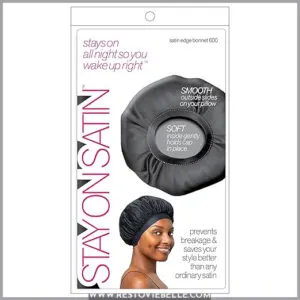
The Stay on Satin Edge Bonnet Hair Wrap is a satin bonnet designed to protect your hair while you sleep.
It features a patented wide folded spandex satin edge band instead of elastic, which is comfortable and holds the bonnet in place all night long.
The bonnet is made without abrasive exposed Velcro or elastic, ensuring it doesn’t damage or break delicate hair around the edges.
It’s also machine washable and dryable.
Best For: Those who want to protect their hair while sleeping.
- Protects hair from damage
- Keeps hair moisturized
- Reduces frizz
- May not be suitable for people with very thick or long hair
- May not be comfortable for people who sleep on their stomachs
- May not stay on all night if you toss and turn a lot
Jamaican Black Castor Oil 8oz Pack of 2
Jamaican Black Castor Oil 8oz Pack of 2 is a popular product for hair regrowth due to its rich nutrients and potential benefits. This oil is known for its high concentration of essential fatty acids, particularly omega-9, which nourishes the hair follicles and promotes healthy hair growth. It also contains vitamin E, minerals, and proteins that strengthen the hair shaft**, making it less susceptible to damage and breakage.
To use Jamaican Black Castor Oil for hair care, it can be used as a hot oil treatment after shampooing or applied regularly to the scalp to stimulate hair growth. It can also be used for skin care, as it’s rich in essential fatty acids and vitamin E, which are known for their nourishing and moisturizing properties.
The oil is made from roasted, ground, and boiled castor beans, and the roasting process gives it its characteristic dark color and raises its alkalinity, which is beneficial for hair health. It’s also organic and sulfate-free, making it a safe and natural option for hair care.
Jamaican Black Castor Oil has been used for hair growth and skin care for over 4,000 years and is known to moisturize, thicken, strengthen, and rapidly increase hair growth. It’s suitable for all hair types and textures, as it works on the hair roots/follicles and not the hair itself.
Users have reported that the oil helps prevent hair breakage, dandruff, dry and itchy scalp, eczema, thinning hair, alopecia, and bald spots. It can also be used for eyelash and eyebrow hair growth and as a massage oil.
Best For: Those looking to improve hair and skin health.
- Rich in essential fatty acids, vitamin E, and minerals
- Nourishes and strengthens hair follicles and shaft
- Moisturizes and protects the skin
- Viscous and sticky
- Strong odor
- Can damage hair ends if applied directly
Mielle Organics Babassu Mint Deep Conditioner
Mielle Organics Babassu Mint Deep Conditioner is a popular choice for those seeking to regrow their edges. This conditioner is designed to strengthen hair elasticity, reduce breakage, and nourish the hair and scalp.
It contains babassu oil, mint, and other natural ingredients that penetrate and replenish follicles and skin, adding definition and lasting shine to curls, waves, coils, and chemically-treated styles.
It’s safe for all hair types, including color-treated hair, braids, weaves, and both low and high porosity level hair.
To use it, simply apply it to damp hair, cover with a plastic cap, and leave it on for 15-20 minutes before rinsing.
For best results, use it weekly or bi-weekly.
Best For: Those seeking to regrow their edges, strengthen hair elasticity, reduce breakage, and nourish the hair and scalp.
- Strengthens hair elasticity
- Reduces breakage
- Nourishes hair and scalp
- Strong mint smell
- May require blow drying with a protective spray for coarser hair
- May be too heavy for fine hair
Mixed Chicks Detangling Deep Conditioner
Mixed Chicks Detangling Deep Conditioner is a product that can help you achieve soft, moisturized, and manageable hair. It’s suitable for all hair types, including those with dry, damaged, or frizzy hair. The conditioner is infused with safflower oil, which penetrates and reconstructs damaged areas, transforming style-resistant locks into resilient, easy-to-maintain tresses. It also protects hair from styling damage caused by coloring, heat styling, and chemically treating hair.
To use the Mixed Chicks Detangling Deep Conditioner, apply it to wet hair, focusing mainly on the mid-lengths to ends. Comb through the hair and leave it on for 5-10 minutes before rinsing well. Follow up with Mixed Chicks Leave in Conditioner for added benefits. The conditioner is vegan and comes in an 8-ounce pack. It’s also available in other sizes, such as 6.7-ounce, 12-ounce, 8-ounce, 9-ounce, and 33-ounce packs.
The Mixed Chicks Detangling Deep Conditioner is a popular choice among users, with many praising its ability to detangle and soften hair. It’s also appreciated for its nourishing and moisturizing properties, which help to reduce breakage and promote healthy hair growth.
Best For: Individuals with dry, damaged, or frizzy hair seeking a deep moisturizing and detangling treatment.
- Effectively detangles and softens hair
- Nourishes and moisturizes hair, reducing breakage
- Protects hair from styling damage
- May not be suitable for all hair types
- Some users may find the fragrance too strong
- Not travel-friendly due to the 2-ounce size
NatureLab Tokyo Perfect Clean Clarifying Scalp Scrub
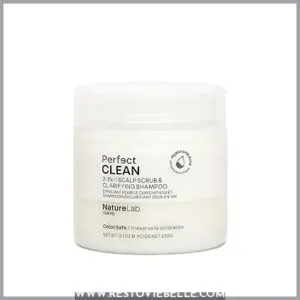
NatureLab Tokyo Perfect Clean Clarifying Scalp Scrub is a 2-in-1 sugar scrub and shampoo that gently removes product buildup and environmental impurities from the scalp, revealing a healthy scalp and immensely shiny hair.
This product is formulated with probiotic-rich sake water, which balances the scalp’s natural pH level for a healthy scalp, and antioxidant-rich grape extract, which revitalizes shine.
Additionally, hyaluronic acid seals in moisture, and pearl extract stimulates enzymes for an iridescent finish.
Best For: Those with product buildup or environmental impurities on their scalp.
- Gently removes product buildup and environmental impurities
- Revitalizes shine and seals in moisture
- Stimulates enzymes for an iridescent finish
- May not be suitable for all hair types
- May not be as effective as a traditional shampoo and conditioner
- May be difficult to find in stores
Understanding Edge Thinning
Edge thinning is a common issue that affects many people, particularly those with textured hair. It can be caused by a variety of factors, including genetics, stress, traction alopecia, postpartum shedding, and the use of relaxers. Traction alopecia, for example, is a form of hair loss caused by prolonged or repetitive tension on the hair due to tight braids, locks, and other hairstyles. It can affect men, women, and children, but is most commonly seen in women of African descent.
Stress can also contribute to edge thinning. High levels of stress can cause hair loss, and this is particularly true for the hair around the hairline, which is more sensitive. Additionally, hairstyles that pull can lead to hair loss, such as tight ponytails, braids, or buns.
Postpartum shedding is another cause of edge thinning. After giving birth, many women experience increased hair shedding, which can lead to thinning around the hairline.
Relaxers can also contribute to edge thinning. The chemicals in relaxers can damage the hair and scalp, leading to hair loss over time.
To prevent edge thinning, it’s important to identify and address the cause of damage. This may involve avoiding damaging hairstyles, washing hair regularly with sulfate-free shampoo, using repairing products, and getting scalp massages. It’s also important to maintain a healthy diet, as a balanced diet high in antioxidants can help promote hair growth.
Genetic Factors
Genetics have a vital impact on establishing the growth timeline for your edges. Factors such as your inherent hair texture and growth rate can substantially affect the pace at which your edges recover their volume.
Genetic Factors
Genetics play a significant role in hair growth and loss. Your genes can influence hair density, length, color, and texture. For example, specific genes are associated with differences in hair thickness, and certain genetic predictors have been identified for male pattern baldness. Additionally, genetics can also predispose individuals to hair disorders such as Telogen effluvium and Alopecia areata.
When it comes to hair growth, genetics can affect the growth cycle of hair follicles, leading to shorter and finer strands of hair in the case of male pattern baldness. In women, female pattern baldness is determined at birth, with smaller hair follicles and thinner strands. Genes from both parents contribute to hair loss, with the most dominant hair loss gene located on the X chromosome, which comes from the mother.
While genetics can’t be completely reversed, natural and botanical ingredients can help support hair growth and address disrupted hair health. Supplements like those from Nutrafol, which include ingredients like saw palmetto and ashwagandha, can help support hair growth by addressing hormonal imbalances and supporting the endocrine system.
Growth Timeline
The growth timeline for edges is influenced by genetics, tension from hairstyles and chemical treatments, medical conditions, and hormonal changes. Hair grows 1/2 inch per month, but it takes about three months to see a difference. Patience is key, as there’s no overnight fix. Consistent healthy routines are essential for edges regrowth.
Nutrition Impact
To foster thicker edges, a balanced diet is paramount. Prioritize consuming antioxidant-laden foods such as fruits, vegetables, spinach, red peppers, and avocado. A protein-based leave-in conditioner and intensive conditioning treatments can further bolster hair growth. While genetics exert an influence, adopting a nutritious diet and implementing targeted scalp treatments can elevate your hair’s health and density.
Tension From Hairstyles and Chemical Treatments
Tension from hairstyles and chemical treatments can lead to a condition known as traction alopecia. This form of hair loss is caused by prolonged or repetitive tension on the hair due to tight hairstyles, such as braids, locks, and weaves. The use of hair extensions, chemical relaxers, and tight ponytails can also contribute to this condition.
Traction alopecia can result in hair breakage, thinning, and even permanent scarring hair loss. It’s most commonly seen in women of African descent, affecting up to one-third of this population. Early on, this condition doesn’t scar and is reversible, but long-term traction alopecia can lead to permanent hair loss.
To prevent traction alopecia, it’s essential to identify and address the cause of damage. Avoid damaging hairstyles, such as tight braids and weaves, and opt for loose hairstyles instead. Regularly washing your hair with sulfate-free shampoo can also help maintain hair health. In addition, using repairing products and getting scalp massages can stimulate hair growth.
If you suspect you have traction alopecia, it’s essential to consult a healthcare professional for proper diagnosis and treatment. Early intervention can help prevent further damage and potentially restore hair growth.
Medical Conditions or Hormonal Changes
Hormonal imbalances and medical conditions can greatly contribute to edge thinning. Hormonal changes due to pregnancy, childbirth, and menopause can lead to hair loss, as well as conditions like polycystic ovary syndrome (PCOS) and thyroid issues. These hormonal fluctuations can cause hair follicles to shrink, leading to finer and thinner hair or even hair loss.
Treating hormonal hair loss may involve talking to an endocrinologist to rebalance hormones and using medications like minoxidil or Rogaine. Additionally, addressing any underlying medical conditions can help promote hair growth and prevent further hair loss.
Preventing Edge Thinning
Are your edges thinning out? Take action to prevent further damage by identifying and addressing the root cause, avoiding hairstyles that put stress on your edges, and incorporating regular scalp massages into your haircare routine. These steps can help create an ideal environment for your edges to regrow.
Identify and Address the Cause of Damage
To prevent edge thinning, it’s essential to determine and resolve the root cause of damage. This might involve refraining from restrictive hairstyles, being delicate when brushing hair, giving heat tools a break, and hydrating edges. Knowledge and upkeep are paramount, along with an understanding of your hair’s vulnerability to breakage and delicate hairs.
Hair oils, hair thickening fibers, and protective hairstyles can also contribute to the prevention process.
Avoid Damaging Hairstyles
To avoid damaging hairstyles, switch to gentler options like scalp treatments, gentle brushing, and wearing a silk bonnet or satin scarf. Opt for heat protectant sprays and natural remedies like Jamaican black castor oil. Incorporate a hair oil into your routine and use a boar bristle hair brush for detangling. Remember, a healthy routine is key to preventing edge thinning.
Wash Hair Regularly With Sulfate-Free Shampoo
Washing your hair regularly with sulfate-free shampoo is a pivotal step in fostering hair growth and deterring breakage. This delicate approach to hair care aids in preserving hair integrity and safeguarding your scalp, laying the groundwork for alluring, dense edges.
Indulge in restful sleep and nurture your tresses with sulfate-free shampoo, and you’ll embark on the path to rejuvenating your edges.
Get Scalp Massages
A scalp massage can be a game-changer for promoting hair growth and overall scalp health. Here’s how to incorporate it into your routine:
- Scalp Massage Techniques: Use your fingertips to apply gentle pressure in circular motions on your scalp. You can also use a scalp massager for more even pressure without tiring your hands.
- Scalp Massage Frequency: Aim for 3-4 times a week or even twice a day if needed.
- Scalp Massage Pressure: Use enough pressure to shift your scalp and feel it moving forward and backward a bit when you grasp your hair.
- Scalp Massage Tools: Consider using a scalp massager for a more efficient massage.
- Scalp Massage Benefits: Regular scalp massages can improve scalp health, reduce stress, and promote hair growth by stimulating blood circulation.
Stimulating Hair Growth
Stimulating your hair growth is key to regrowing those thinning edges. Try light therapy, scalp massages, gentle brushing, deep conditioning treatments, and a protein-rich diet to kickstart the regrowth process.
Light Therapy
Light therapy is a popular method for stimulating hair growth and promoting edge regrowth. This non-invasive treatment involves the use of low-level light therapy (LLLT) devices, which emit specific wavelengths of light to stimulate hair follicles and encourage new hair growth.
The science behind light therapy for hair loss is rooted in the fact that light, particularly red light, can penetrate the scalp and stimulate blood flow, which in turn promotes hair growth. Studies have shown that LLLT can improve hair count and density in people with male pattern baldness, and it has been found to be safe and effective for hair loss treatment.
While the exact mechanism of how light therapy works isn’t fully understood, it’s believed that the light energy is absorbed by weak cells in the scalp, which then stimulates hair follicles to grow hair. This non-invasive treatment can be done at home with the use of LLLT caps or in-office treatments, and it has minimal side effects compared to other hair loss treatments.
It’s essential to note that while light therapy can be effective, it may not work for everyone, and its effectiveness can vary depending on the individual’s hair loss condition and the severity of the hair damage. It’s also vital to maintain a consistent and healthy hair care routine, which includes avoiding damaging hairstyles, washing hair regularly with sulfate-free shampoo, and using repairing products to prevent further damage.
Scalp Massage
Scalp massages boost blood flow, enhancing nutrient absorption and scalp hydration, while reducing inflammation and tension, paving the way for healthier, more resilient hair edges.
Gentle Brushing
Gentle brushing is an important part of a healthy hair care routine. It helps to stimulate the scalp, promoting hair growth. Here are four tips to make sure you’re brushing correctly:
- Use a wide-tooth comb for wet hair.
- Start from the ends and work your way up.
- Be gentle to avoid damaging your hair.
- Choose the right brush for your hair type.
Deep Conditioning Treatments
Essential conditioning treatments play a pivotal role in hair growth by ensuring moisture retention and protein restoration for damaged hair. Integrate deep conditioning treatments into your hair care regimen to achieve optimal scalp well-being and hair growth.
Protein-Rich Diet
Boost your protein intake to stimulate hair growth. Consider protein supplements, shakes, or powders if you’re deficient. A balanced diet rich in protein sources like lean meats, eggs, and legumes can help your edges regrow.
Thickening Hair Edges
To thicken thinning hair edges, use regular deep conditioning treatments to nourish and strengthen the fragile strands. Incorporate hair oils like Jamaican black castor oil, peppermint essential oil, and monoi oil into your regimen; their concentrated nutrients can promote healthy hair growth and density along the hairline.
Regular Deep Conditioning Treatments
After stimulating growth, embark on a regular deep conditioning regimen to strengthen edges. Envision:
- A weekly coconut oil hair mask
- Bi-weekly castor oil treatments
- Monthly scalp scrubs
- Fortnightly deep conditioning
Hair Oils for Natural Hair
Discover the power of hair oils for natural hair in your edge regrowth journey. Explore the properties and benefits of various natural hair oil options, such as jojoba, argan, and coconut oil. Essential oils like peppermint and rosemary can also stimulate hair growth. Incorporate these ingredients into your hair care routine for a healthier, thicker look.
Jamaican Black Castor Oil
Jamaican Black Castor Oil (JBCO) is a popular choice for those seeking to thicken their hair edges. Here are five key points about JBCO that can help you understand its effectiveness:
- Viscosity: JBCO’s thick consistency gives the appearance of fuller and longer hair, making it a popular choice for those looking to enhance their hair’s appearance.
- Nourishing Properties: The oil is rich in omega-6 and omega-9 fatty acids, which nourish the scalp and strengthen hair roots, improving blood flow to the scalp and encouraging new hair growth.
- Prevention of Hair Breakage: JBCO can help prevent hair breakage, making it a valuable tool for those with damaged or easily breakable hair.
- Healing and Prevention of Split Ends: JBCO can help heal and prevent split ends, which are common issues for those with thinning hair.
- Deep Conditioning Treatment: JBCO can be used as a deep conditioning treatment, with some users suggesting leaving it on overnight for maximum benefits.
To use JBCO effectively, follow these steps:
- Application: Apply a tablespoon of JBCO and a tablespoon of jojoba oil to your scalp and roots, massaging it in with circular motions.
- Coverage: Cover your head with plastic wrap and leave the oil on for two hours, or overnight for a deep conditioning treatment.
- Washing: Wash your hair as you normally would after using JBCO, ensuring to rinse the oil out thoroughly.
- Consistency: For best results, use JBCO twice a week, combining it with mustard oil for an even more effective treatment.
Peppermint Essential Oil
Peppermint essential oil is a popular choice for hair growth and scalp health due to its cooling menthol content. It can increase circulation to the scalp, promoting hair growth during the anagen phase. A study found that a 3% peppermint oil combination outperformed an FDA-approved hair growth drug (minoxidil) regarding hair growth, making the hair thicker and faster.
To use peppermint oil for hair growth, mix 2 drops of peppermint essential oil with your choice of carrier oil, such as coconut or olive oil. Massage it into your scalp and leave it on for 5 minutes before washing it out thoroughly with shampoo and conditioner.
Monoi Oil
Monoi oil is a popular choice for hair care, particularly for those looking to thicken their edges. This fragrant oil, which is often referred to as Tahitian oil, is made by soaking Gardenia Tahitensis flowers in coconut oil for a month. The result is an oil that’s rich in vitamins B1, B2, B3, B6, C, and E, as well as minerals like magnesium, which contributes to the production of proteins like keratin.
To use monoi oil for hair growth, you can apply it directly to your hair and scalp, focusing on areas where you want to promote growth. You can also use it as a pre-shampoo treatment, leaving it on for 30 minutes to several hours before shampooing, or as an overnight treatment for added hydration. Monoi oil penetrates deeply into the hair shaft, moisturizing and strengthening it from within, thereby preventing breakage and promoting growth.
In addition to its direct application, monoi oil can be found in various hair care products, such as shampoos, conditioners, and serums. This allows you to enjoy its benefits daily without the need for separate treatments. To get the most out of monoi oil, it’s recommended to use it as part of a holistic approach to hair growth, which includes scalp massage, deep conditioning, and protective measures like avoiding heat styling and tight hairstyles.
When it comes to hair growth, patience is key. While monoi oil can help promote healthy hair growth, it won’t produce overnight results. It’s important to maintain a consistent, healthy routine and give your hair the time it needs to grow back.
Condition of Edges/Nape Before Regrowth
The state of your edges and nape area prior to regrowth can vary considerably. Your hair may seem bare, diminishing, scattered, reduced to under a quarter of an inch, or you could encounter a retreating hairline. Determining the degree of damage is vital in establishing the necessary course of action and setting reasonable anticipations for the regrowth period.
Bald
Bald edges can be a source of worry for many individuals. Comprehending the reasons for damage and the period of hair damage is vital for effective regrowth.
Damage can last years or even over a decade. With the suitable regrowth methods** and persistence, you can see results in 2-3 months to 4 years.
Identify the reason for damage. Avoid damaging hairstyles. Add a protein-rich diet for ideal hair health.
Thinning
Thinning edges can be caused by a variety of factors, including genetic predisposition, tension from hairstyles and chemical treatments, medical conditions or hormonal changes, and stress. Genetics play a significant role in hair growth and loss, with some individuals naturally experiencing thinning around the edges due to their genetic makeup. Tension from hairstyles and chemical treatments, such as tight braids, weaves, and relaxers, can also contribute to thinning edges by damaging the hair follicles and causing traction alopecia. Medical conditions, like alopecia areata or androgenic alopecia, can also lead to thinning edges. Hormonal changes, such as those associated with pregnancy or menopause, can also cause thinning edges.
To grow back thinning edges, it’s crucial to address the underlying cause of damage. This may involve avoiding damaging hairstyles, washing hair regularly with sulfate-free shampoo, using repairing products, and getting scalp massages. Regular deep conditioning treatments, hair oils, and essential oils can also help stimulate hair growth and thicken edges. Scalp care, including hydrating treatments, scrubs, and serums, can also promote a healthy scalp environment for hair growth.
The timeline for edge regrowth varies, as hair grows at an average rate of 1/2 inch per month. It may take about three months to see a noticeable difference, but patience and consistency are key to achieving visible results. There’s no overnight fix for edge regrowth, and results depend on the individual’s hair growth cycle and the severity of damage.
Sparse
If your edges are sparse, it’s imperative to tackle the underlying reasons. Scalp treatments and hair products can aid in stimulating growth. Bear in mind, patience is essential, as hair only grows approximately 1/2 inch per month.
Broken Down to Less Than 0.25 Inches
If your hair density is low and your hair is broken down to less than 0.25 inches, it’s imperative to prioritize scalp health and hair growth.
Begin by steering clear of damaging hairstyles and chemical treatments.
Consistent deep conditioning treatments, hair oils, and scalp massages can aid in promoting regrowth.
Bear in mind, patience is paramount as hair grows 1/2 inch per month, and it could take up to three months to observe a change.
Receding Hairline
If you’re dealing with a receding hairline, don’t panic!
It’s imperative to comprehend that stress, hairstyles, products, and hair tools can contribute to hair damage and thinning.
To regrow your edges, concentrate on identifying and addressing the cause of damage.
Refrain from damaging hairstyles.
Cleanse your hair regularly with sulfate-free shampoo.
Receive scalp massages.
Duration of Hair Damage
The extent of hair damage leading to edge thinning or loss can vary greatly, spanning from several months to more than a decade or even becoming an enduring challenge. If you have endured extended periods of edge damage lasting years or your entire life, it may necessitate more time and unwavering efforts to revitalize your edges to their best state.
Years
If your hair loss has been an issue for years, it’s time to focus on hair regrowth.
Hair damage can take a long time to reverse.
With patience and the right hair care routine, you can promote healthy hair growth.
Start by identifying the cause of your hair loss, such as genetics or tension from hairstyles.
Then, be gentle with your hair.
Avoid harsh chemicals.
Nourish your scalp with hydrating treatments.
Be patient and consistent with your hair care routine.
Over a Decade
If your hair damage has persisted for over a decade, it’s essential to tackle the contributing factors.
Such factors include scalp treatments, nutritional deficiencies, and hair growth stages.
Scalp treatments can assist in boosting growth.
A balanced diet rich in antioxidants can supply the vital nutrients for hair well-being.
Regular deep conditioning treatments and hair oils can also encourage edge growth.
Perseverance is vital, as it may take several months to observe results.
Always Had Issues
If you’ve always had issues with thinning edges, it’s time to take control. Identify the cause, such as hormonal imbalances or stress. Try home remedies like Jamaican black castor oil or peppermint essential oil. Protective styles can help, but avoid damaging hairstyles. Practice stress management and maintain a balanced diet. Remember, patience is key.
7. 9 Months
If you’ve been dealing with edge thinning for 7-9 months, it’s essential to take precautionary measures. Determine the cause, refrain from harmful hairstyles, wash frequently with sulfate-free shampoo, and receive scalp massages. Products that enhance hair strength and nourish the scalp can also be beneficial.
A Few Months
If your edges have only been damaged for a few months, you’re in luck. With the right care, like reducing product buildup and managing stress, you can bounce back quickly.
Frequently Asked Questions (FAQs)
What is the best way to maintain healthy edges?
You’d be surprised – 60% of people experience edge thinning. To keep those baby hairs lush, massage your edges weekly with a nourishing oil like castor or coconut. Gentle care and consistency are key to edge-ucating those strands back to life, my friend.
Can certain hairstyles cause thinning edges?
Yes, certain hairstyles like tight ponytails, braids, or weaves can certainly tug on your delicate edges, leading to traction alopecia and thinning over time. It’s essential to avoid excessive tension and give your edges a break from those styles.
What role do medical conditions play in edge thinning?
Certain medical conditions or hormonal changes can absolutely wreak havoc on your edges. Things like thyroid issues, nutritional deficiencies, or an imbalance in your hormones can trigger thinning or loss in those delicate areas.
How long does it take for edges to grow back after damage?
Hair edges regrow at a rate of 1/2 inch per month. You’re lookin’ at 3-6 months to see significant progress after damage. Consistency with a healthy routine is key – no magic potions for overnight results, unfortunately.
What are the best natural hair products for growing edges?
For growing back those edges, you can’t go wrong with castor oil, peppermint oil, or aloe vera gel. These natural powerhouses nourish, stimulate growth, and give your hairline some much-needed TLC.
Conclusion
Regaining full edges demands unwavering commitment, akin to nurturing a delicate seedling.
While how long it takes for edges to grow back varies, diligent scalp care, nourishing oils, and patience are indispensable.
Identify the root cause, whether genetics, tension, or medical factors, and tailor your regrowth strategy accordingly.
Consistent scalp massage, a protein-rich diet, and reparative treatments will cultivate an environment primed for robust edge revival.
Persevere, and your hairline will flourish anew.

